Probably the best way to enjoy hard-boiled eggs! Chinese tea eggs are packed with flavor and have a beautiful marble look. They make a great high-protein and low-calorie snack.
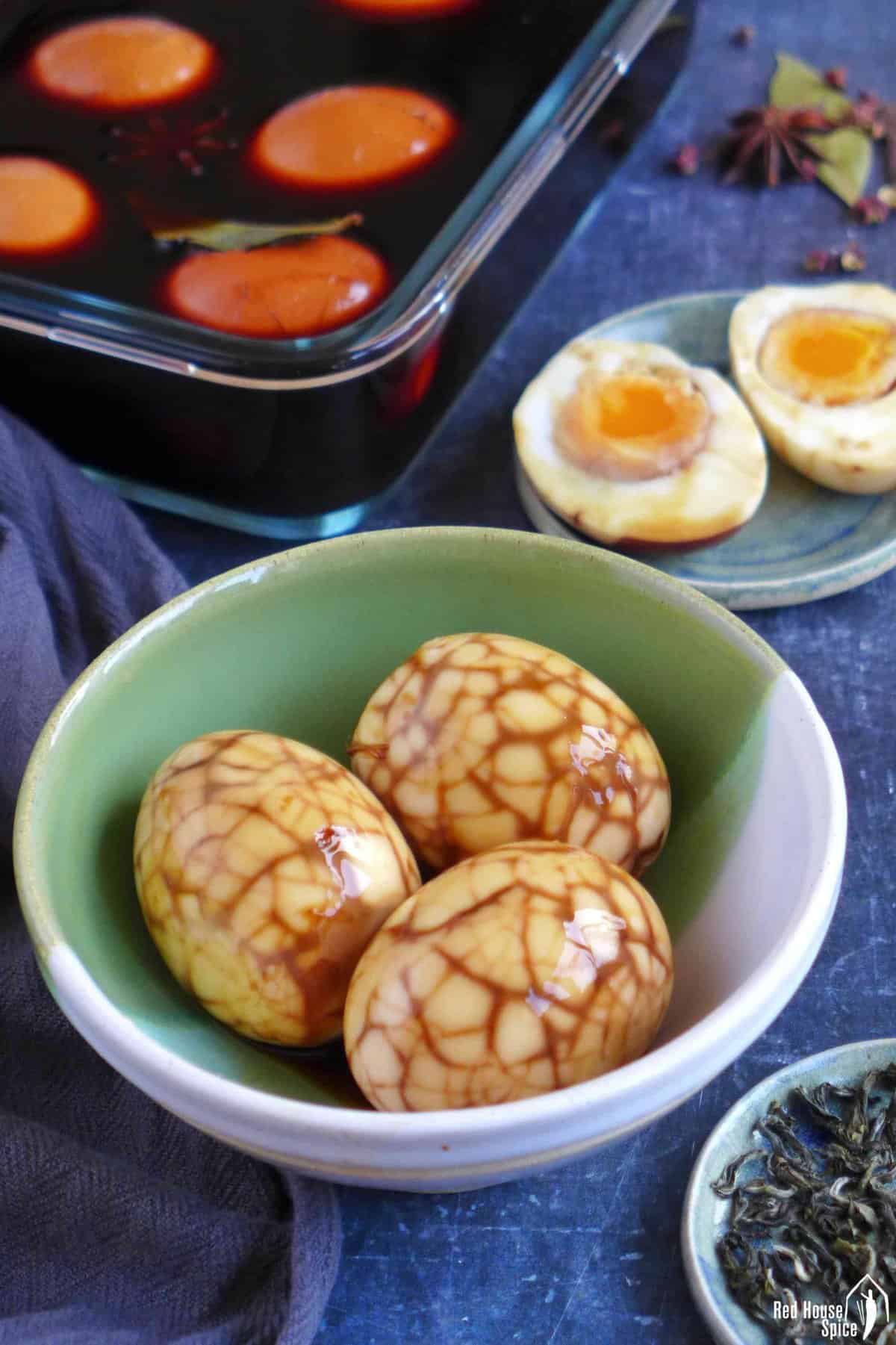
Jump to:
Note: This is a revised version of my post published in 2017. It provides more tips and process shots.
The memories of my happy childhood are often food related. The recent school trip my daughter took reminded me of a particular food that I always ate on school excursions when I was her age. It was Chinese tea eggs, a simple and humble food that is popular in every region of China.
What are tea eggs
Tea eggs, known as Cha Ye Dan/茶叶蛋 or Cha Ji Dan/茶鸡蛋 in Chinese, are hard-boiled eggs that are cracked and soaked in a marinade infused with tea, spices and soy sauce. This intensely flavored liquid not only seasons the eggs but also creates a marble appearance. Hence they are also referred to as marbled eggs or tea-smoked eggs in English.
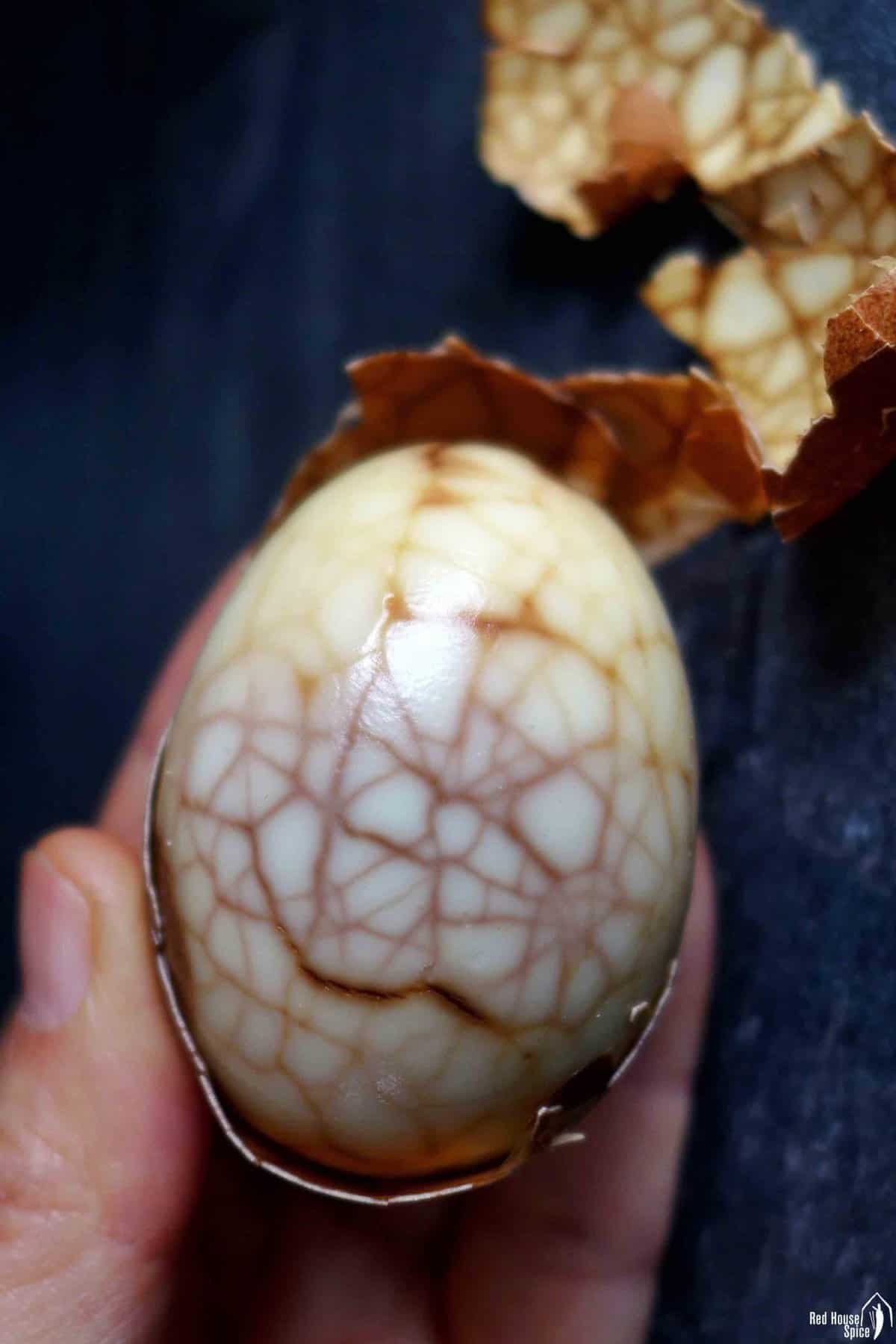
During the steeping process, the marinade seeps through the cracks and leaves a marble pattern on the egg whites, while the egg yolks absorb some flavor and become creamier and less dry than regular hard-boiled eggs.
Different home cooks and street food vendors have their own unique variations of tea egg recipes. The taste varies depending on the choice of tea, spices, soy sauce quantity, steeping time, etc. However, all versions share a similar profile: savory, umami, and aromatic, with a hint of sweetness and a smoky undertone.
Top tips
Before diving into the detailed recipe, keep these tips in mind:
- Feel free to choose any tea you prefer or have on hand.
- Dark soy sauce is essential for the best marbling effect.
- Reduce the boiling time if you prefer soft yolks.
- Adjust the steeping time according to your desired saltiness.
- Reuse the marinade for future batches.
Ingredients & substitutes
Eggs
Hen eggs are used in Chinese tea eggs, but I also cook quail eggs from time to time (they absorb the flavor more effectively).
Tea
Which type of tea? You may ask. There isn’t a set rule. Simply choose what’s available in your house or the one with your preferred aroma. However, herbal tea isn’t suitable for this recipe.
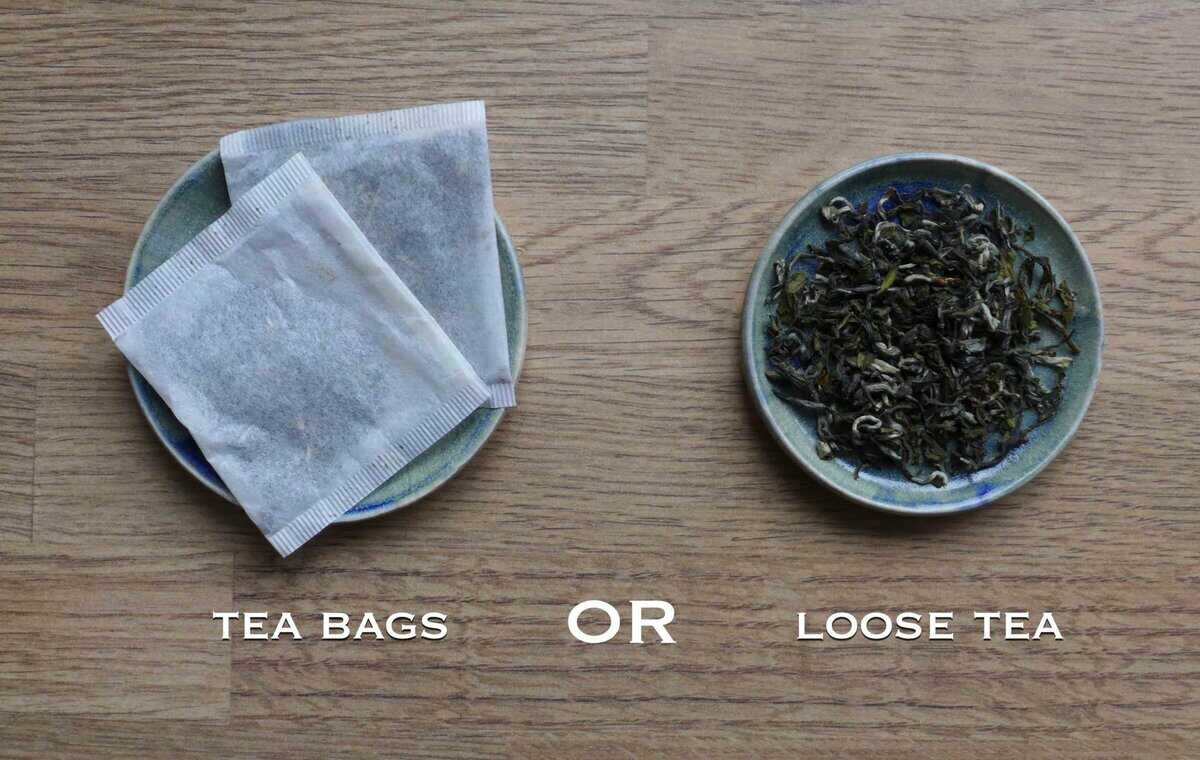
My parents use green tea (often the one infused with jasmine flowers) to make tea eggs. This is simply because it’s the most common type of tea in Chinese households.
Through testing, I found regular black tea to be a very good alternative. It’s cheap, easily accessible, and creates a more effective marble look. Either tea bags or loose tea leaves can be used.
Other types of tea, such as oolong, pu-erh, white tea, etc. are all fine for this recipe. I personally wouldn’t use very expensive ones (better save them for drinking).
Spices
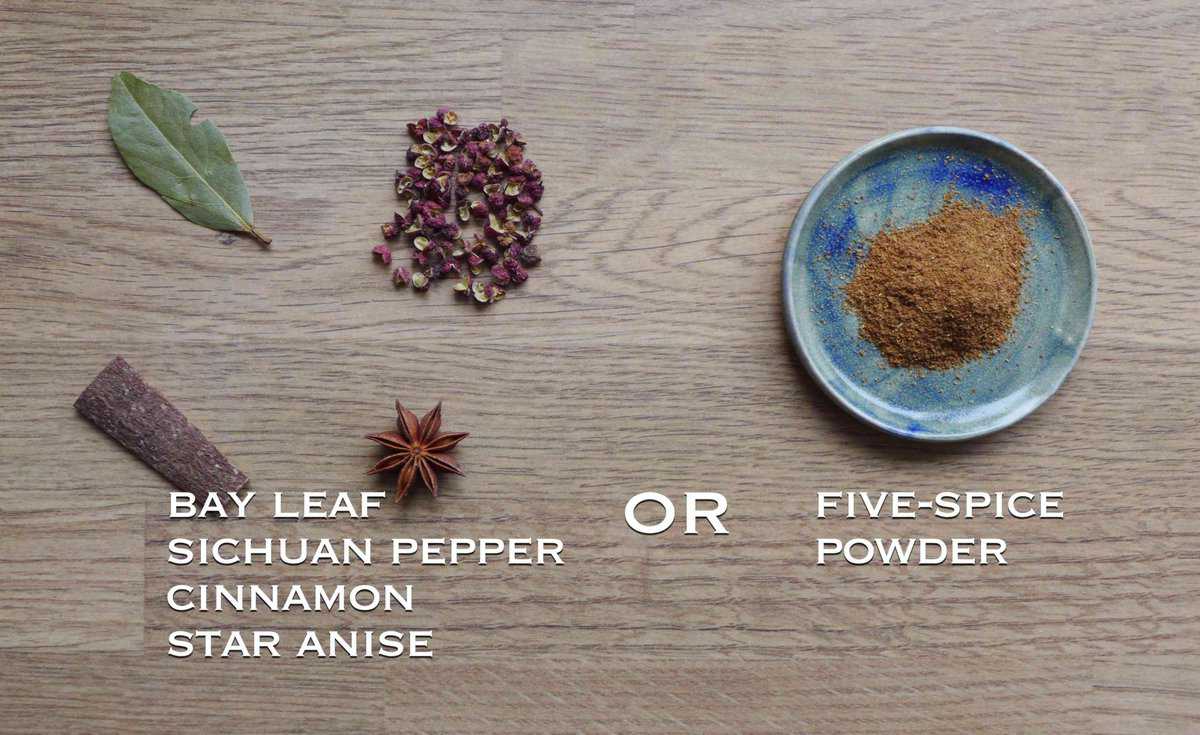
I use a few common Chinese spices to enhance the flavor. They include star anise, Chinese cinnamon stick (cassia cinnamon), bay leaf and Sichuan pepper. If you enjoy a hint of heat, add a few dried chili peppers too.
It’s fine to omit 1-2 spices or add a few extra, such as fennel seeds, cloves, tangerine peels, etc.
Don’t have any whole spices? No worries! Replace them with a teaspoon of Chinese five-spice powder. It works well too.
Seasonings
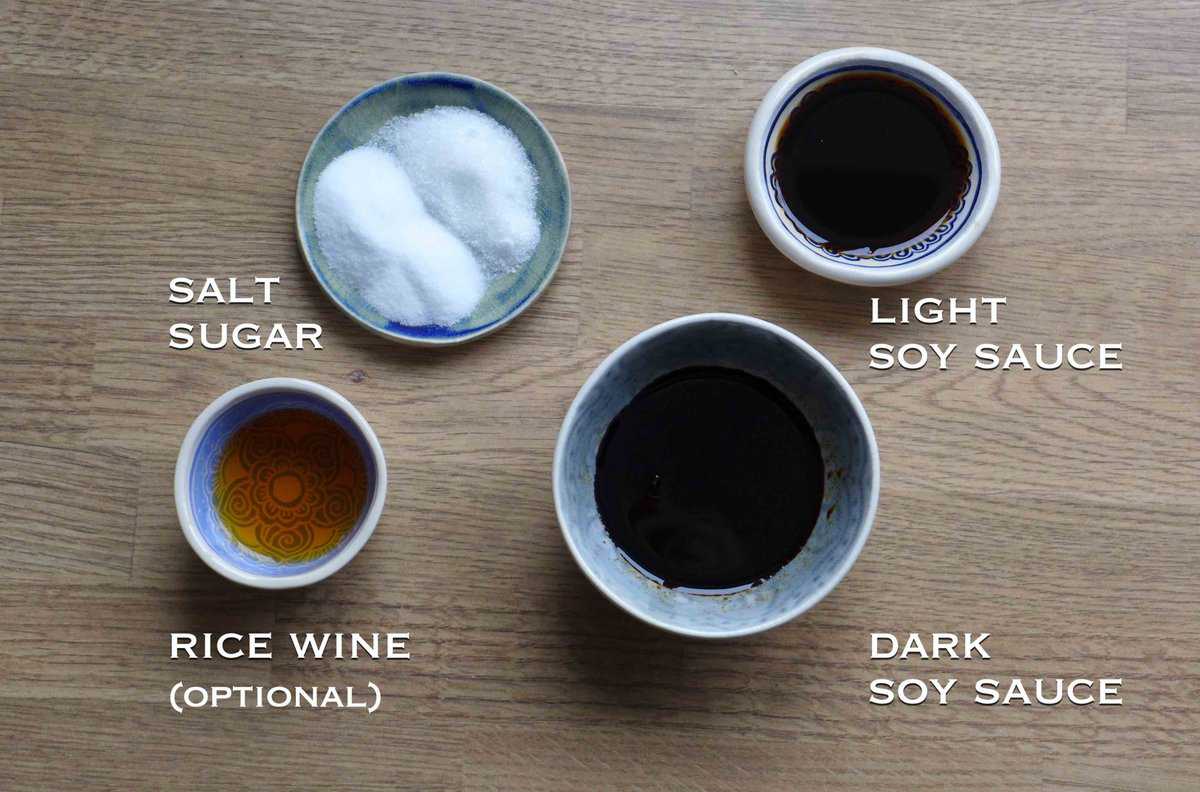
Soy sauce is essential to this recipe. The light version provides aroma and salty flavor, while the dark version helps to create the marble effect effortlessly.
Add a little Shaoxing wine if you happen to have some (it’s fine to skip it). Finally, include some salt and sugar (any type).
Cooking procedure
Step 1: Boil the eggs
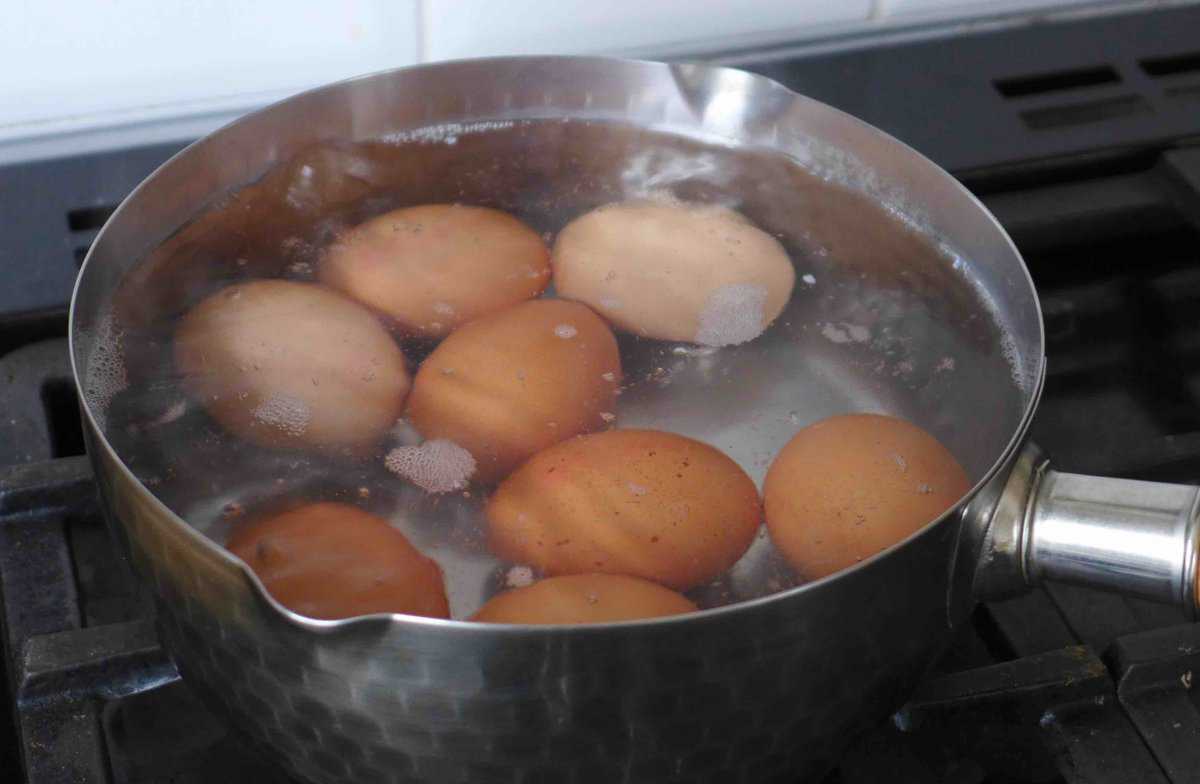
Bring a pot of water to a boil, then gently place the eggs in the water and cook over medium heat for 8 minutes.
The cooking time required depends on the size, quantity and temperature of the eggs. For testing this recipe, I used 8 large, room-temperature eggs. Adjust the time if you’re cooking less or more eggs, or your eggs are smaller, chilled, etc.
🛎 Want runny yolks?
Classic tea eggs are hard-boiled. In other words, the yolks are fully cooked. If you prefer runny yolks (like soy sauce eggs found in Japanese ramen), reduce the boiling time to 7 minutes.
Step 2: Prepare the marinade
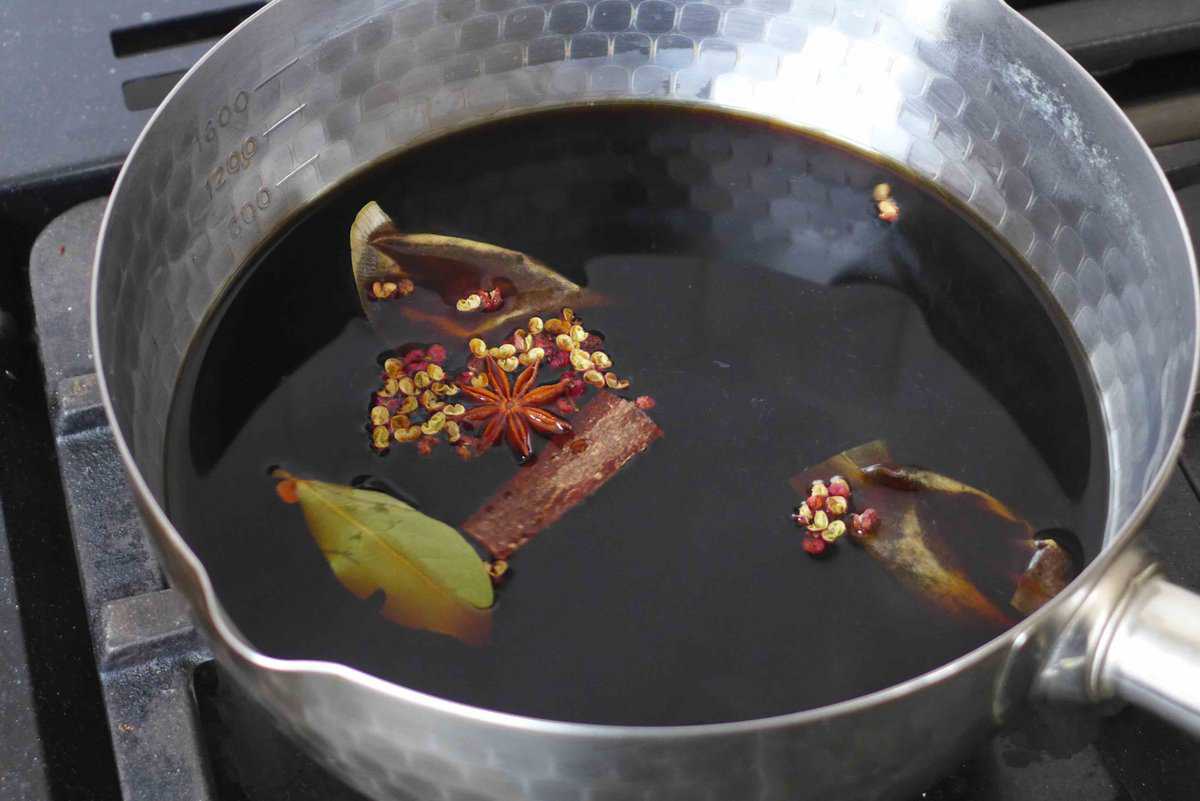
While waiting for the eggs to cook, gather all the spices and seasonings for the marinade and place them in a saucepan with 2 cups of water. Bring the mixture to a boil, then let it simmer for about 3 minutes.
Step 3: Cool & crack the eggs

Immediately after cooking, transfer the boiled eggs to a bowl of cold water (tap water) to stop them from being further cooked.
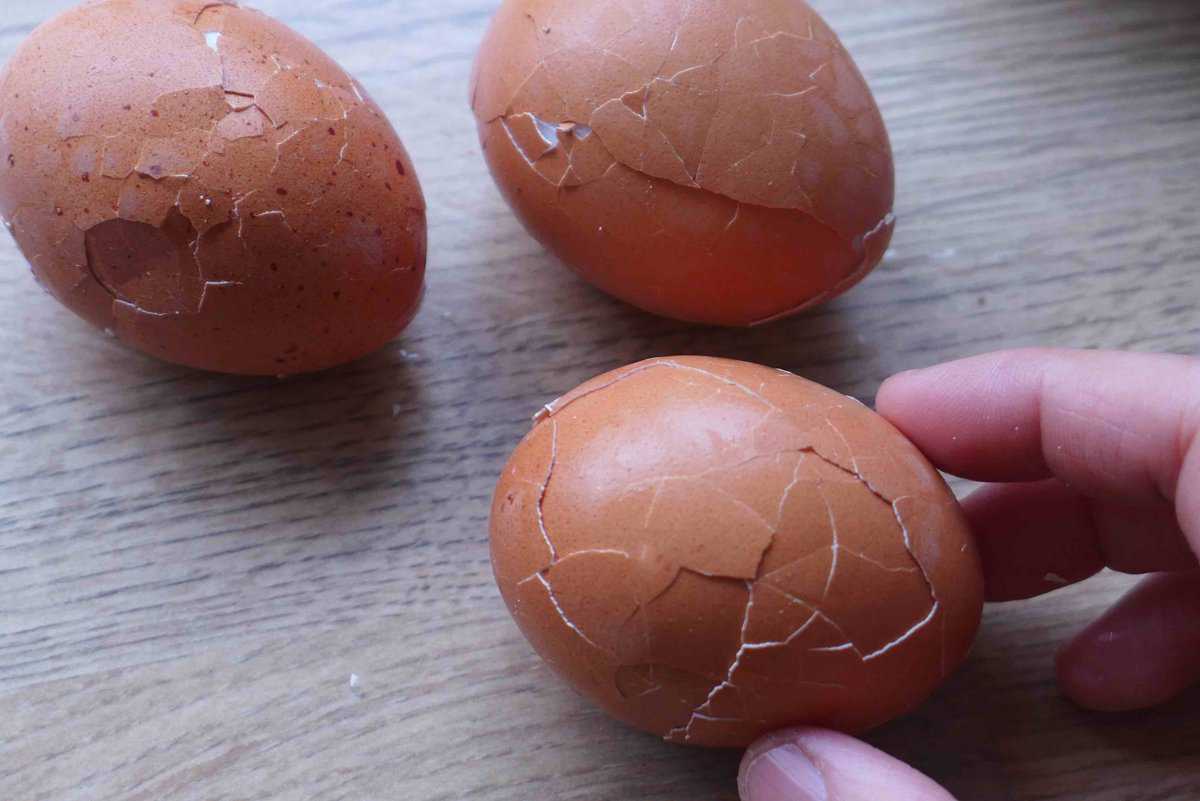
Once they are cool enough to handle, gently crack the egg shells all around. You can do so against the kitchen counter or use the back of a spoon.
🛎 Note: The cooling process will dramatically reduce the heat of the eggs so that they aren’t cooked further.
Step 4: Steep the eggs
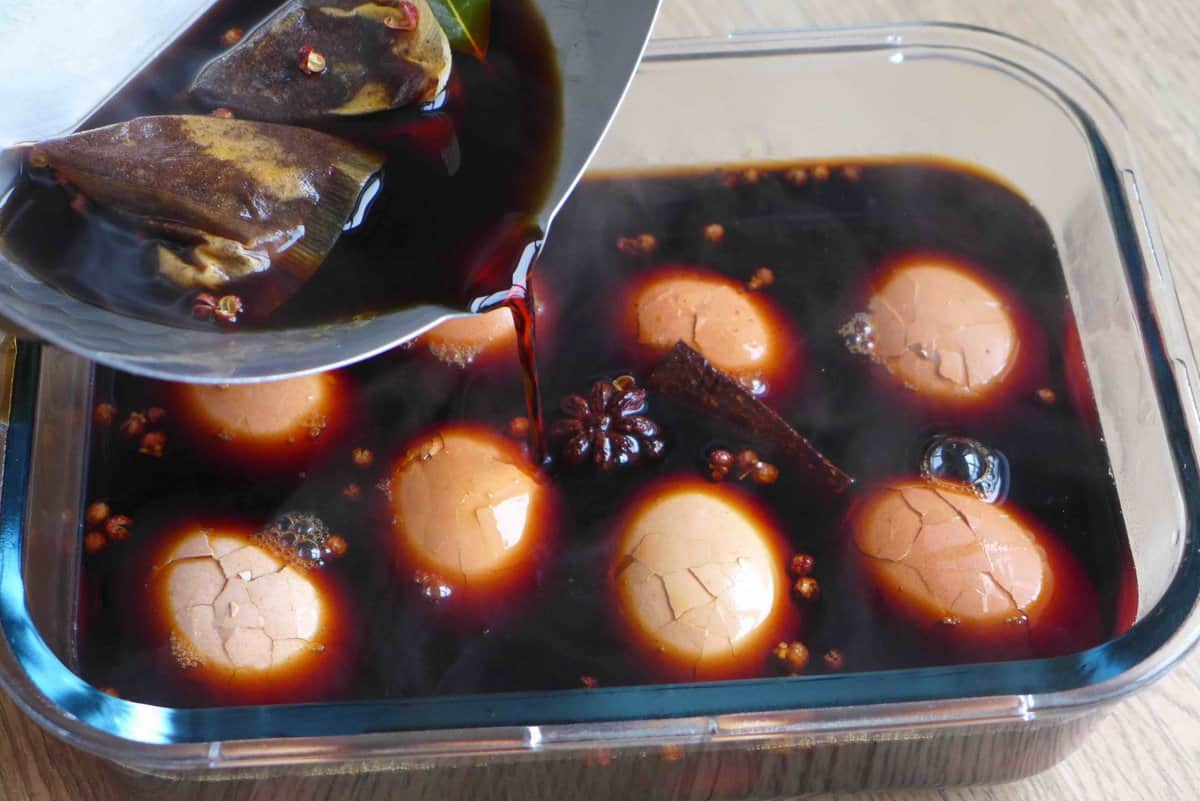
Put all the eggs in a container. Then pour in the marinade, along with the tea and spices. Cover with a lid and let the eggs steep for 12 to 24 hours.
🛎 Note: It’s best to use a container that can fit all the eggs snuggly. This way the marinade fully covers the eggs ensuring an even coloring. If not, flip the eggs once during the steeping process.
Alternatively, use a resealable plastic bag to marinate the eggs. Make sure to squeeze out any air before you seal it.
Tips on the marble effect
There are three factors that affect the marbling result. Consider these if you’re after a striking look.
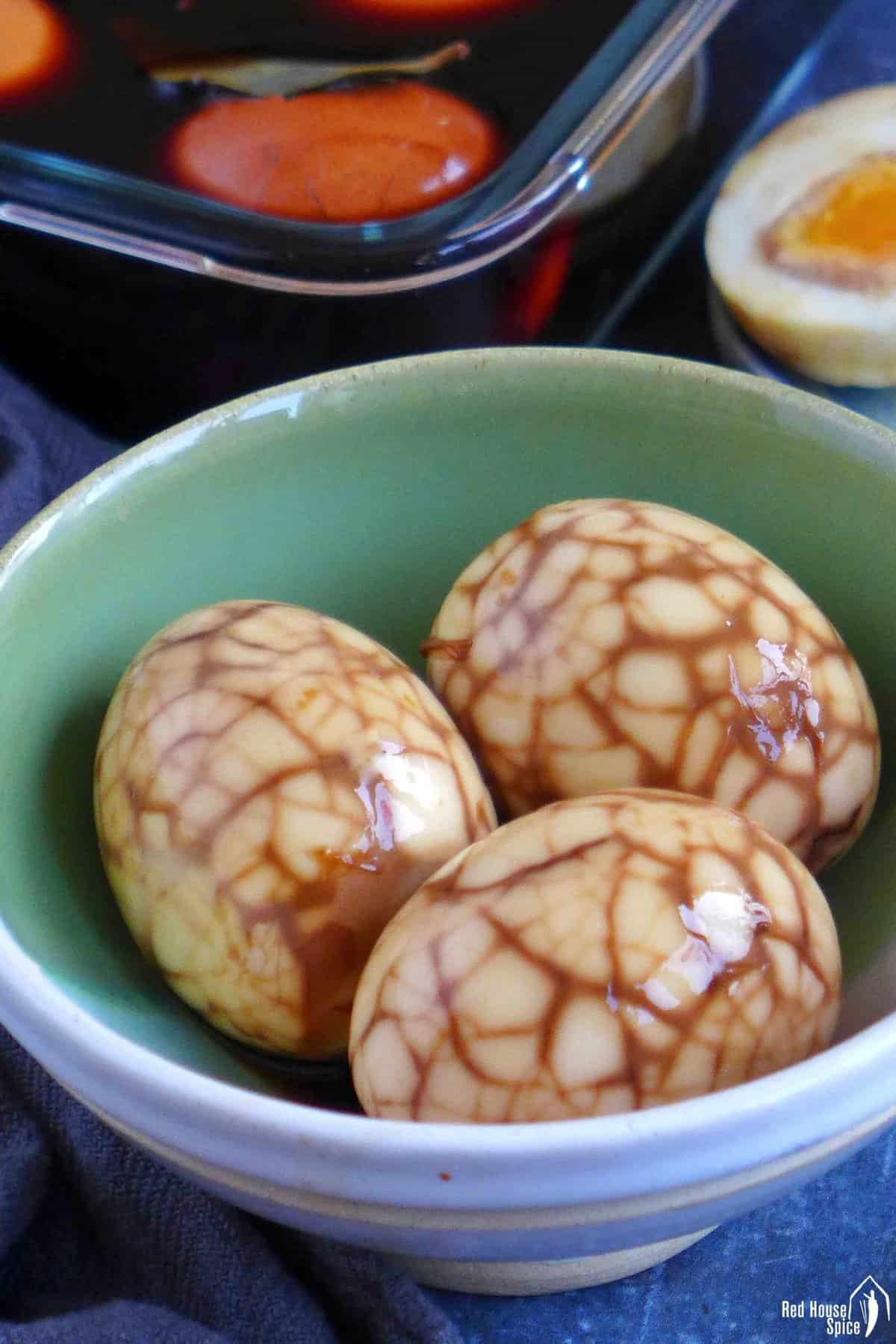
- The steeping time. The longer the eggs stay in the marinade, the more intense the marble look.
- Tea. Generally speaking, black tea (Known as Hong Cha/红茶 in Chinese) produces the darkest color.
- Dark soy sauce. Don’t skip this ingredient which is commonly used in Chinese cuisine for browning food (Think Red Braised Pork Belly). You may increase its volume and reduce the salt accordingly.
Storage advice
If your kitchen isn’t overly hot, it’s fine to leave the container on the kitchen counter for 12 hours. If longer, place it in the fridge.
The marble stains, flavor and saltiness of the eggs will intensify as the steeping time extends. However, be aware that the eggs might become too salty if you leave them in the marinade for over 24 hours.
After being removed from the steeping liquid, these tea eggs can be stored in the fridge for another 4 days.
Reuse the marinade
Like how master stock (Lu Shui/卤水) is preserved in Chinese cooking, I often reuse the tea egg marinade for subsequent batches. However, as the flavor and saltiness decrease with each use, you’d need to top up the tea, spices and seasonings when necessary.
Also, to reduce the risk of bacteria growth, I suggest you freeze the marinade between uses and reboil it each time before using it again.
Serving ideas
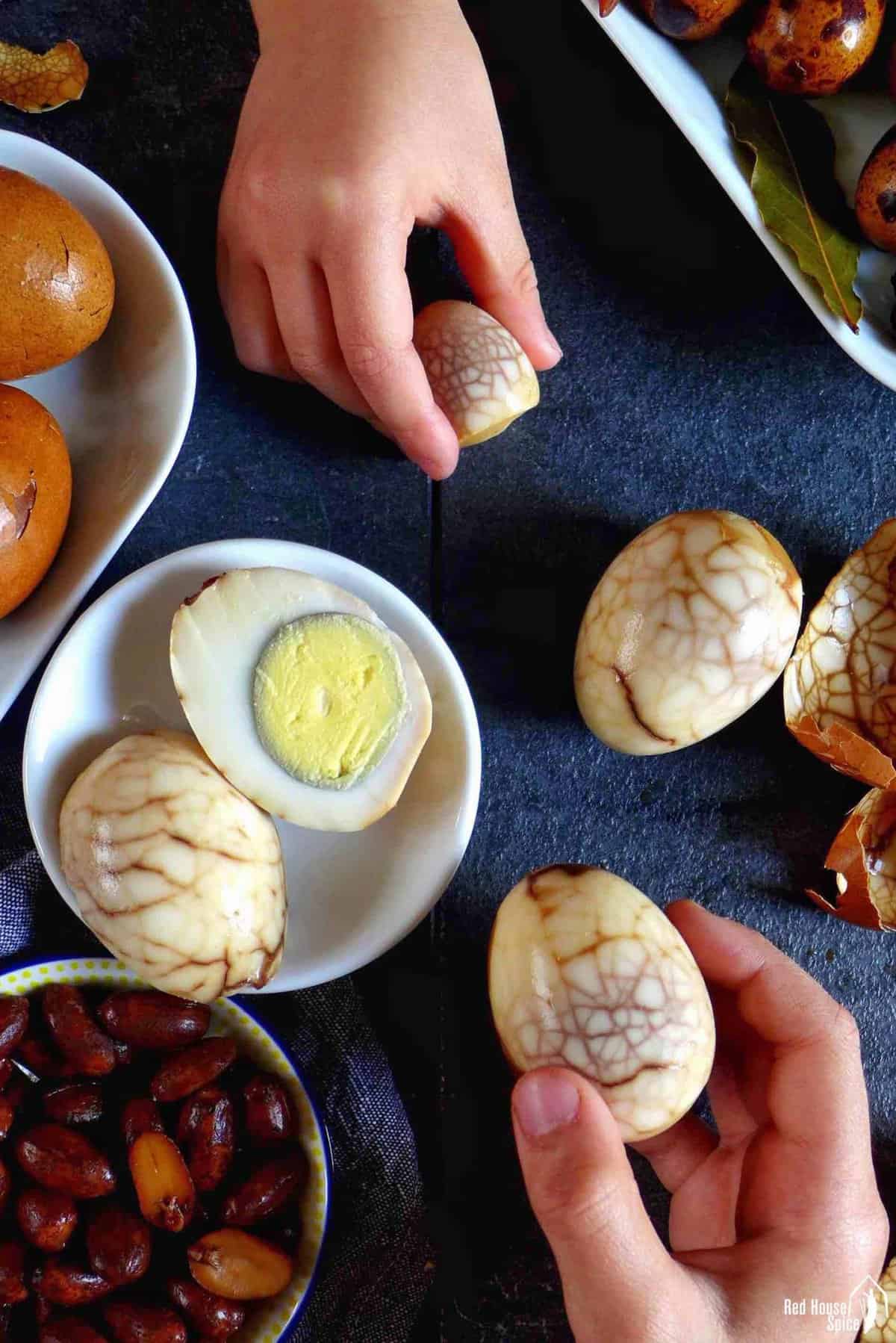
There are so many ways to enjoy these tea eggs. I grew up eating them at breakfast or as an after-school snack. And they were an essential item to bring on a journey, either on lengthy train trips or for short excursions. So tasty and handy!
Other serving ideas include:
- Over a bowl of steamed rice, along with other savory toppings, just like how you enjoy Lu Rou Fan (Taiwanese pork rice bowl).
- Add it to your favorite noodle dishes. In my hometown, tea eggs are a popular addition to Lanzhou Beef Noodle Soup.
- Put them into your packed lunches (bento), or smash them in between sliced bread to make a quick sandwich.
- Use it as a topping for Congee (Chinese rice porridge). Add a dash of homemade chili oil and some chopped scallions/cilantro.
📋 Recipe
Love this recipe? Please leave a 5-star 🌟🌟🌟🌟🌟 rating in the recipe card below & if you REALLY like it, consider leaving a comment as well!
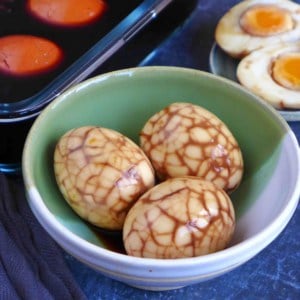
Chinese Tea Eggs (茶叶蛋)
Ingredients
- 8 eggs - at room temperature (see note 1)
- 2 bags black tea - or 1 tablespoon of loose tea (see note 2)
- 1 star-anise - see note 3
- 1 bay leaf
- 1 piece Chinese cinnamon - aka cassia cinnamon
- ½ teaspoon Sichuan peppercorn
- 2 tablespoon dark soy sauce
- 1 tablespoon light soy sauce
- 1 teaspoon Shaoxing rice wine - optional
- ½ tablespoon sugar
- 2 teaspoon salt
Instructions
- Bring plenty of water (enough to cover all the eggs) to a full boil in a pot/saucepan. Gently slide in all the eggs. Leave to boil uncovered over medium heat for 8 minutes (if you prefer runny yolks, reduce the time to 7 minutes).
- While waiting for the egg to cook, put all the other ingredients into a clean saucepan. Add 2 cups (500ml) of water. Bring to a boil then leave to simmer for 3 minutes. Set aside.
- When the eggs are cooked, transfer them to a large bowl of cold water. Once they’re cool enough to touch, gently crack them one by one against the kitchen counter making sure the shells are cracked all around.
- Place the eggs in a container (ideally one that can fit them snuggly). Pour in the marinade. Cover with a lid and leave to steep for 12 to 24 hours before serving (see note 4).
- To reuse the leftover marinade: Freeze it if you don’t plan to make another batch soon. Add more tea, spices and seasonings when necessary. Always boil it for each use to prevent bacteria growth.
NOTES
NUTRITION
NUTRITION DISCLOSURE: Nutritional information on this website is provided as a courtesy to readers. It should be considered estimates. Please use your own brand nutritional values or your preferred nutrition calculator to double check against our estimates.


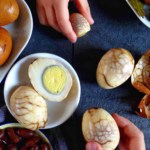
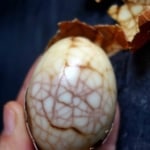
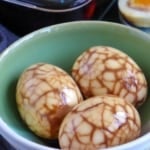

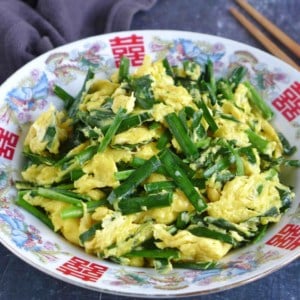
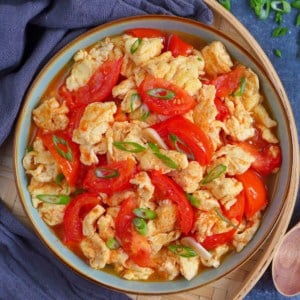
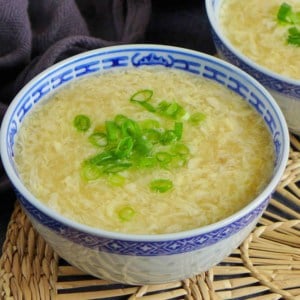

Excellent recipe. Made eggs for the week on Sunday, they were great on Friday. Thank you.
Glad you enjoyed the recipe, Pat!
I made them yesterday for try. They are really good and they look good! Perfect decoration of the Easter table. The only problem I have is that the marble effect sometimes doesn’t look like marble but like a big stain. I can’t feel the perfect cracks level 😀 Too much makes stains, but I think that too little cracks on shells won’t make good marble.
I’ve never thought about making tea eggs for Easter. But why not! Yes, it can be quite tricky to crack the shells perfectly. Glad you enjoyed the taste.
Delicious, thankyou Wei!!!
It was so easy and tasty!
That’s wonderful to hear!
I agree with you
I plan to make your Marbled Egg Recipe today, & I’m so looking forward to tasting them! This recipe brings back memories from about 20 years ago when my college roommate made them for a dinner with my parents. They were Wonderful! I have never had them since then. I can’t wait!!
Thank you Kathy for sharing your food story. Hope you enjoy cooking tea eggs and they bring back nice memories.